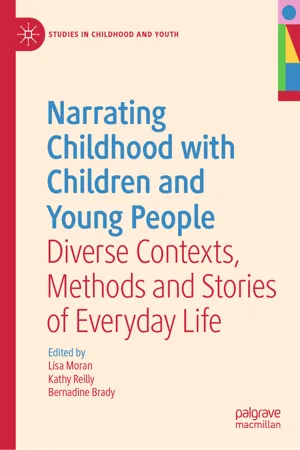Storytelling is a universally recognisable genre inherent in all human life. The ability to narrate transcends difference, providing a space from where stories are made and unmade, through the voices (however manifest) of storytellers. The capacity to narrate does not discriminate by gender, age or class, nor is it limited contextually. Instead, stories prioritise the voice(s) and perspective(s) chosen of and by storytellers and by extension, every story is laden with silence(s), elements of life and context that remain untold, suppressed and/or, are absent. This implies that storytelling is a powerful act, with the capacity to prioritise particular perspectives over others. Storytelling is not limited to the pages of a book or an oral account, but represents a variety of communicative structures including pictures and performances (e.g. song and dance) and accounts of everyday life in a multitude of places and spaces. In the life of a child, storytelling is implicit both as storyteller and listener; stories form part of everyday life, providing portals to explore the (often) imaginative worlds offered by and through the lens of a story, while offering children and young people opportunities to narrate experiences that shape and reflect their life experiences.
Research engaging narrative or storytelling as a method has increased significantly since the 1980s, with contributions from scholars across multiple and diverse fields. Among these contributors are literary theorists, sociologists, educational researchers, linguists, anthropologists, psychotherapists, veterinary specialists, social work and social care researchers, scholars from medical and health sciences, and geographers. By the 1990s, Connelly and Clandinin (1990) argued for an emerging ‘narrative revolution’ across the social sciences (Clandinin 2006; Connelly and Clandinin 1990).1 This was further influenced by the emergence of humanist approaches in post-war sociology and psychology which precipitated a more general interest in predominantly person-centred methodological approaches, including life histories, biographies and oral history methods (Ibid.). The concepts of ‘narrative’ and ‘narrative inquiry’, along with questions about what it means to narrate in relation to the social positioning of narrators, listeners and tellers, are now accorded prominence in academic scholarship across disciplinary boundaries (Riessman 2002). Sandelowski (1991, p. 162) argues for an interpretation of narrative as an ‘interactive and interpretive product’ comprised of stories, actions, happenings, characters and plots (Riessman 2002) while researchers have underlined how intersections between physical environments and social life continuously shape and reflect narratives and storytelling (Anderson and Jones 2009; Koller and Farley 2019).
Not surprising, given the ‘narrative turn’ in social science research, there has been increasing use of narrative approaches in research with children and young people (de Leeuw et al. 2017). Narrative methods hold great appeal for social science researchers as they allow diverse and varied groups of children and young people to tell stories about their lives in a relatively organic way (Hill and Dallos 2011), providing a ‘portal’ into their lived experiences (Reeves 2007; Tomanović 2012; Bartik et al. 2013). Through the telling of stories and subsequent analysis, narrative inquiry provides a space to understand difference and the wider socio-historical, political and cultural events that shape experiences of inclusion and exclusion for children and young people (Goodley and Clough 2004).
This edited volume represents a collection of scholarly peer-reviewed contributions from diverse, yet interlinking disciplinary fields, with the central aim of critically examining the value of
narrative inquiry in understanding the everyday lives of
children and
young people across multiple and diverse
contexts. Bringing together research findings and methodological insights from
sociology,
geography,
education,
child and youth studies,
social care and
social work, the volume emphasises the importance of narrative,
children’s voices and
storytelling methodological approaches, as applied in
social science research with
children and
young people. The volume points to the
diversity of
spaces and places encountered by children and
youth considering how
young people ‘tell tales’ about their lives (e.g. written
essays,
online platforms, visual
methods, narrative interviews), highlighting the
multidimensionality of narrative research in capturing their
everyday lived
experiences. Given the increasing prominence accorded to
young people’s participation in contemporary
society (Lundy 2018), the
voices and agencies of these groups indelibly shape areas of pivotal importance to global citizenries, making this volume extremely timely. The aims of the volume are:
- 1.
To bring together a diversity of approaches to narrative inquiry, underlining the multifarious ways that these concepts are understood in research with children and young people across a range of disciplines and research contexts.
- 2.
To examine the value of narrative research approaches for understanding children and young people’s ‘everyday’ experiences in distinctive settings (e.g. home, community, schools).
- 3.
To create a deeper understanding of how different narrative research methods are utilised specifically in research studies with children and young people (...
